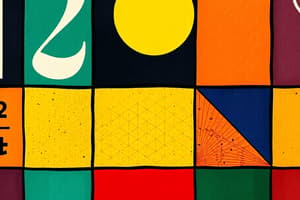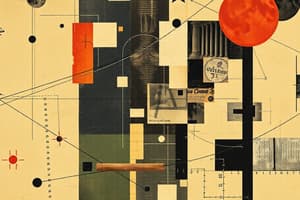Podcast
Questions and Answers
Pure mathematics focuses on the practical applications of mathematical principles in fields like engineering, rather than studying mathematics for its own sake.
Pure mathematics focuses on the practical applications of mathematical principles in fields like engineering, rather than studying mathematics for its own sake.
False (B)
Arithmetic, as the foundational branch of mathematics, primarily focuses on complex algebraic equations and abstract reasoning, rather than basic numerical operations.
Arithmetic, as the foundational branch of mathematics, primarily focuses on complex algebraic equations and abstract reasoning, rather than basic numerical operations.
False (B)
The set of irrational numbers is closed under addition, meaning the sum of any two irrational numbers is always also irrational.
The set of irrational numbers is closed under addition, meaning the sum of any two irrational numbers is always also irrational.
False (B)
In Algebra, Boolean algebra manipulates variables that can assume only two values, such as 0 and 1, making it particularly useful in digital logic and computer science.
In Algebra, Boolean algebra manipulates variables that can assume only two values, such as 0 and 1, making it particularly useful in digital logic and computer science.
The expression $x^2 + 5 = 0$ has real number solutions.
The expression $x^2 + 5 = 0$ has real number solutions.
Euclidean geometry, distinguished by its reliance on Euclid's axioms, readily applies to the surface of a sphere without modification.
Euclidean geometry, distinguished by its reliance on Euclid's axioms, readily applies to the surface of a sphere without modification.
In Geometry, hyperbolic geometry, unlike Euclidean geometry, violates the parallel postulate by allowing infinitely many lines through a point parallel to a given line.
In Geometry, hyperbolic geometry, unlike Euclidean geometry, violates the parallel postulate by allowing infinitely many lines through a point parallel to a given line.
The Pythagorean theorem, which gives the relationship between the sides of a right triangle, only holds true in Euclidean space.
The Pythagorean theorem, which gives the relationship between the sides of a right triangle, only holds true in Euclidean space.
Trigonometric functions like sine and cosine are inherently limited to calculations within right triangles and cannot be extended to analyze angles beyond 90 degrees.
Trigonometric functions like sine and cosine are inherently limited to calculations within right triangles and cannot be extended to analyze angles beyond 90 degrees.
The tangent function, defined as $\tan(x) = \frac{\sin(x)}{\cos(x)}$, is continuous for all real numbers $x$.
The tangent function, defined as $\tan(x) = \frac{\sin(x)}{\cos(x)}$, is continuous for all real numbers $x$.
Differential calculus focuses primarily on determining the area under curves and accumulating quantities, rather than analyzing rates of change and slopes of functions.
Differential calculus focuses primarily on determining the area under curves and accumulating quantities, rather than analyzing rates of change and slopes of functions.
If $f'(x) > 0$ for all $x$ in an interval, then $f(x)$ is decreasing on that interval.
If $f'(x) > 0$ for all $x$ in an interval, then $f(x)$ is decreasing on that interval.
In statistics, the median is always equal to the mean in any data set.
In statistics, the median is always equal to the mean in any data set.
A p-value of 0.06 indicates stronger evidence against the null hypothesis than a p-value of 0.01.
A p-value of 0.06 indicates stronger evidence against the null hypothesis than a p-value of 0.01.
In probability theory, if two events are mutually exclusive, then they are independent.
In probability theory, if two events are mutually exclusive, then they are independent.
Graph theory, an area of discrete mathematics, is fundamentally limited to representing concrete, physical networks and cannot be applied to abstract relationships or data structures.
Graph theory, an area of discrete mathematics, is fundamentally limited to representing concrete, physical networks and cannot be applied to abstract relationships or data structures.
Set theory primarily focuses on continuous functions and their properties, making it a crucial foundation for calculus and real analysis.
Set theory primarily focuses on continuous functions and their properties, making it a crucial foundation for calculus and real analysis.
The halting problem, central to theoretical computer science and addressed within discrete mathematics, is decidable, meaning an algorithm exists that can determine whether any given program will halt or run forever.
The halting problem, central to theoretical computer science and addressed within discrete mathematics, is decidable, meaning an algorithm exists that can determine whether any given program will halt or run forever.
The intersection of two disjoint sets contains all elements from both sets.
The intersection of two disjoint sets contains all elements from both sets.
Cryptography, which relies heavily on number theory, ensures data security by transforming information into an unreadable format, protecting it from unauthorized access.
Cryptography, which relies heavily on number theory, ensures data security by transforming information into an unreadable format, protecting it from unauthorized access.
Flashcards
What is Mathematics?
What is Mathematics?
The abstract science of number, quantity, and space, studied in its own right (pure mathematics) or applied to other disciplines (applied mathematics).
What is Arithmetic?
What is Arithmetic?
The oldest and most elementary branch of mathematics, dealing with basic operations on numbers.
What is Algebra?
What is Algebra?
Generalizes arithmetic by using symbols to represent numbers and quantities, solving equations and exploring relationships.
What is Geometry?
What is Geometry?
Signup and view all the flashcards
What is Trigonometry?
What is Trigonometry?
Signup and view all the flashcards
What is Calculus?
What is Calculus?
Signup and view all the flashcards
What are Statistics and Probability?
What are Statistics and Probability?
Signup and view all the flashcards
What is Discrete Mathematics?
What is Discrete Mathematics?
Signup and view all the flashcards
What are Number Systems?
What are Number Systems?
Signup and view all the flashcards
What are Expressions?
What are Expressions?
Signup and view all the flashcards
What are Equations?
What are Equations?
Signup and view all the flashcards
What is a Function?
What is a Function?
Signup and view all the flashcards
What are Points?
What are Points?
Signup and view all the flashcards
What are Lines?
What are Lines?
Signup and view all the flashcards
What are Angles?
What are Angles?
Signup and view all the flashcards
What is a Plane?
What is a Plane?
Signup and view all the flashcards
What is Area?
What is Area?
Signup and view all the flashcards
What is Volume?
What is Volume?
Signup and view all the flashcards
What is a Theorem?
What is a Theorem?
Signup and view all the flashcards
What are Trigonometric Functions?
What are Trigonometric Functions?
Signup and view all the flashcards
Study Notes
- Mathematics is the abstract science of number, quantity, and space
- It can be studied in its own right (pure mathematics) or as it is applied to other disciplines such as physics and engineering (applied mathematics)
Arithmetic
- Arithmetic is the oldest and most elementary branch of mathematics
- It deals with basic operations on numbers: addition, subtraction, multiplication, and division
- It forms the foundation for more advanced topics like algebra and calculus
- Key concepts include number systems (natural, integer, rational, real, complex), fractions, decimals, percentages, ratios, and proportions
Algebra
- Algebra generalizes arithmetic by using letters or symbols to represent numbers and quantities
- It is used to solve equations and explore relationships between variables
- Key concepts include variables, expressions, equations, inequalities, functions, and graphs
- Different types of algebraic structures exist, such as linear algebra, abstract algebra, and Boolean algebra
Geometry
- Geometry deals with the properties and relations of points, lines, surfaces, and solids
- Euclidean geometry, based on Euclid's axioms, is the standard geometry taught in schools
- Key concepts include points, lines, angles, shapes (triangles, circles, polygons), area, volume, and geometric theorems (e.g., Pythagorean theorem)
- Other types of geometries exist, such as non-Euclidean geometries (spherical, hyperbolic) and differential geometry
Trigonometry
- Trigonometry studies the relationships between the angles and sides of triangles
- It is essential for solving problems involving distances, heights, and angles
- Key concepts include trigonometric functions (sine, cosine, tangent), trigonometric identities, and the unit circle
- Applications include surveying, navigation, and physics
Calculus
- Calculus deals with the study of continuous change
- It is divided into differential calculus (rates of change and slopes) and integral calculus (accumulation of quantities and areas)
- Key concepts include limits, derivatives, integrals, and functions
- Calculus is used extensively in physics, engineering, economics, and computer science
Statistics and Probability
- Statistics is the science of collecting, analyzing, interpreting, and presenting data
- Probability deals with the likelihood of events occurring
- Key concepts include data types, measures of central tendency (mean, median, mode), measures of dispersion (variance, standard deviation), probability distributions, hypothesis testing, and confidence intervals
- Statistics and probability are used in many fields, including science, business, and government
Discrete Mathematics
- Discrete mathematics deals with mathematical structures that are fundamentally discrete rather than continuous
- It includes topics such as logic, set theory, combinatorics, graph theory, and number theory
- Discrete mathematics is essential for computer science
Studying That Suits You
Use AI to generate personalized quizzes and flashcards to suit your learning preferences.




